Assessing Key Factors Affecting Water Use in Winter Wheat in Slovakia Using Earth Observation Data and Random Forest-Based Model
Abstract
1. Introduction
2. Materials and Methods
2.1. Study Area and Period
2.2. Data
2.2.1. PySEBAL-Derived and Measured ETa
2.2.2. Biophysical Predictors
2.3. Data Analysis
2.3.1. Random Forest Modeling
2.3.2. Network Visualization
Variable Importance
- i.
- Low importance (thin edges): mean decrease accuracy below 10;
- ii.
- Medium importance (medium-sized edges): mean decrease accuracy between 10 and 20;
- iii.
- High importance (thick edges): mean decrease accuracy exceeding 20.
Nature of the Relationship
- i.
- Orange: Linear and monotonic relationship;
- ii.
- Gray: Non-linear and monotonic relationship;
- iii.
- Black: Non-linear and non-monotonic relationship.
Correlation
- i.
- Positive correlation (green): The PDP curve shows an increasing trend;
- ii.
- Negative correlation (red): The PDP curve shows a decreasing trend;
- iii.
- Complex correlation (blue): The PDP curve shows a combination of increasing and decreasing trends.
2.3.3. Model Evaluation
3. Results
3.1. Descriptive Statistics
3.2. Comparison of Lysimeter and PySEBAL-Derived ETa
3.3. Determinants of Actual Evapotranspiration
3.3.1. Assessment of RF Model Performance
3.3.2. Variable Importance
3.3.3. Partial Dependence Plot
3.3.4. Analysis of Soil and Crop Management Factors Interactions on ETa
4. Discussion
5. Conclusions
Supplementary Materials
Author Contributions
Funding
Data Availability Statement
Acknowledgments
Conflicts of Interest
References
- UN-Water. The United Nations World Water Development Report 4: Managing Water under Uncertainty and Risk; World Water Assessment Programme (WWAP); UNESCO: Paris, France, 2012. [Google Scholar]
- FAO. The State of the Worlds Land and Water Resources for Food and Agriculture (SOLAW) Managing Systems at Risk; Food and Agriculture Organization of the United Nations: Rome, Italy, 2011. [Google Scholar]
- Turner, R.K. Economic Valuation of Water Resources in Agriculture: From the Sectoral to a Functional Perspective of Natural Resource Management; Food and Agriculture Organization of the United Nations: Rome, Italy, 2004; Volume 27. [Google Scholar]
- Stehlo, P.; Ková, K. Country Report on the Present Environmental Situation in Agriculture; Food and Agriculture Organization of the United Nations: Rome, Italy, 1999; pp. 88–109. [Google Scholar]
- CIMMYT. From Agronomic Data to Farmer Recommendations: An Economics Training Manual; CIMMYT: Texcoco, Mexico, 1988. [Google Scholar]
- Bolan, S.; Padhye, L.P.; Jasemizad, T.; Govarthanan, M.; Karmegam, N.; Wijesekara, H.; Amarasiri, D.; Hou, D.; Zhou, P.; Biswal, B.K.; et al. Impacts of climate change on the fate of contaminants through extreme weather events. Sci. Total Environ. 2024, 909, 168388. [Google Scholar] [CrossRef]
- Kundzewicz, Z.W. Extreme Weather Events and their Consequences. Pap. Glob. Change IGBP 2016, 23, 59–69. [Google Scholar] [CrossRef]
- Karmakar, P.; Teng, S.W.; Murshed, M.; Pang, S.; Li, Y.; Lin, H. Crop monitoring by multimodal remote sensing: A review. Remote Sens. Appl. Soc. Environ. 2024, 33, 101093. [Google Scholar] [CrossRef]
- Traoré, F.; Bonkoungou, J.; Compaoré, J.; Kouadio, L.; Wellens, J.; Hallot, E.; Tychon, B. Using multi-temporal landsat images and support vector machine to assess the changes in agricultural irrigated areas in the Mogtedo region, Burkina Faso. Remote Sens. 2019, 11, 1442. [Google Scholar] [CrossRef]
- Laborte, A.G.; Maunahan, A.A.; Hijmans, R.J. Opportunities for expanding paddy rice production in Laos: Spatial predictive modeling using Random Forest. J. Land Use Sci. 2012, 7, 21–33. [Google Scholar] [CrossRef]
- Sawadogo, A.; Dossou-Yovo, E.R.; Kouadio, L.; Zwart, S.J.; Traoré, F.; Gündoğdu, K.S. Assessing the biophysical factors affecting irrigation performance in rice cultivation using remote sensing derived information. Agric. Water Manag. 2023, 278, 108124. [Google Scholar] [CrossRef]
- Eitzinger, J.; Žalud, Z.; Alexandrov, V.; Diepen, C.v.; Trnka, M.; Dubrovský, M.; Semeradova, D.; Oberforster, M. A local simulation study on the impact of climate change on winter wheat production in north-eastern Austria. Bodenkultur 2001, 52, 199–212. [Google Scholar]
- Hlavinka, P.; Trnka, M.; Semerádová, D.; Dubrovský, M.; Žalud, Z.; Možný, M. Effect of drought on yield variability of key crops in Czech Republic. Agric. For. Meteorol. 2009, 149, 431–442. [Google Scholar] [CrossRef]
- Kas, M.; Muhlbachova, G.; Kusa, H. Winter wheat yields under different soil-climatic conditions in a long-term field trial. Plant Soil Environ. 2019, 65, 27–34. [Google Scholar] [CrossRef]
- Hlisnikovský, L.; Menšík, L.; Barłóg, P.; Kunzová, E. How Weather and Fertilization Affected Grain Yield and Stability of Winter Wheat in a Long-Term Trial in the South Moravian Region, Czech Republic. Agronomy 2023, 13, 2293. [Google Scholar] [CrossRef]
- Kottek, M.; Grieser, J.; Beck, C.; Rudolf, B.; Rubel, F. World map of the Köppen-Geiger climate classification updated. Meteorol. Z. 2006, 15, 259–263. [Google Scholar] [CrossRef] [PubMed]
- Zeleňáková, M.; Fendeková, M. Key Facts About Water Resources in Slovakia. In Water Resources in Slovakia: Part I: Assessment and Development; Negm, A.M., Zeleňáková, M., Eds.; Springer International Publishing: Cham, Switzerland, 2019; pp. 3–19. [Google Scholar] [CrossRef]
- Novotná, B.; Cviklovič, V.; Chvíla, B.; Minárik, M. Application of Developing Artificial Intelligence (AI) Techniques to Model Pan Evaporation Trends in Slovak River Sub-Basins. Sustainability 2025, 17, 526. [Google Scholar] [CrossRef]
- Kišš, V.; Minárik, M.; Čimo, J.; Tárník, A.; Mikulová, K. Changes in the Agroclimatic Areas of Slovakia in 1961–2020. J. Ecol. Eng. 2023, 24, 293–300. [Google Scholar] [CrossRef]
- FAO. Seed Policy and Programmes for the Central and Eastern European Countries, Commonwealth of Independent States and Other Countries in Transition: Proceedings of the Regional Technical Meeting on Seed Policy Programmes for the Central and Eastern European Countries, Commonwealth of Independent States and Other Countries in Transition, Budapest, Hungary, 6–10 March 2001; Food and Agriculture Organization of the United Nations: Rome, Italy, 2001. [Google Scholar]
- Dorrian, K.; Mkhabela, M.; Sapirstein, H.; Bullock, P. Effects of delayed harvest on wheat quality, gluten strength, and protein composition of hard red spring wheat. Cereal Chem. 2023, 100, 196–212. [Google Scholar] [CrossRef]
- Trezza, R.; Allen, R.G.; Kilic, A.; Ratcliffe, I.; Tasumi, M. Influence of Landsat revisit frequency on time-integration of evapotranspiration for agricultural water management. In Advanced Evapotranspiration Methods and Applications; Bucur, D., Ed.; IntechOpen: London, UK, 2018. [Google Scholar] [CrossRef]
- Fendrich, A.N.; Ciais, P.; Lugato, E.; Carozzi, M.; Guenet, B.; Borrelli, P.; Naipal, V.; McGrath, M.; Martin, P.; Panagos, P. Matrix representation of lateral soil movements: Scaling and calibrating CE-DYNAM (v2) at a continental level. Geosci. Model Dev. 2022, 15, 7835–7857. [Google Scholar] [CrossRef]
- Panagos, P.; Van Liedekerke, M.; Borrelli, P.; Köninger, J.; Ballabio, C.; Orgiazzi, A.; Lugato, E.; Liakos, L.; Hervas, J.; Jones, A.; et al. European Soil Data Centre 2.0: Soil data and knowledge in support of the EU policies. Eur. J. Soil Sci. 2022, 73, e13315. [Google Scholar] [CrossRef]
- Jones, A.; Fernandez-Ugalde, O.; Scarpa, S. Lucas 2015 Topsoil Survey: Presentation of Dataset and Results; EUR 30332; Publications Office of the European Union: Luxembourg, 2020. [Google Scholar] [CrossRef]
- Borrelli, P.; Panagos, P. An indicator to reflect the mitigating effect of Common Agricultural Policy on soil erosion. Land Use Policy 2020, 92, 104467. [Google Scholar] [CrossRef]
- Panagos, P.; Borrelli, P.; Meusburger, K.; Alewell, C.; Lugato, E.; Montanarella, L. Estimating the soil erosion cover-management factor at the European scale. Land Use Policy 2015, 48, 38–50. [Google Scholar] [CrossRef]
- Siebert, S.; Döll, P.; Feick, S.; Hoogeveen, J.; Frenken, K. Global Map of Irrigation Areas; FAO Land & Water: Bonn, Germany, 2007. [Google Scholar]
- Siebert, S.; Henrich, V.; Frenken, K.; Burke, J. Update of the Global Map of Irrigation Areas to Version 5: Project Report; Institute of Crop Science and Resource Conservation: Bonn, Germany, 2013. [Google Scholar]
- R Core Team. R: A Language and Environment for Statistical Computing; R Foundation for Statistical Computing: Vienna, Austria, 2023; Available online: http://www.R-project.org/ (accessed on 25 December 2024).
- Posit Team. RStudio: Integrated Development Environment for R; Posit Software; PBC: Boston, MA, USA, 2023; Available online: http://www.posit.co/ (accessed on 25 December 2024).
- Kouadio, L.; Deo, R.C.; Byrareddy, V.; Adamowski, J.F.; Mushtaq, S.; Phuong Nguyen, V. Artificial intelligence approach for the prediction of Robusta coffee yield using soil fertility properties. Comput. Electron. Agric. 2018, 155, 324–338. [Google Scholar] [CrossRef]
- Prasad, A.M.; Iverson, L.R.; Liaw, A. Newer Classification and Regression Tree Techniques: Bagging and Random Forests for Ecological Prediction. Ecosystems 2006, 9, 181–199. [Google Scholar] [CrossRef]
- Breiman, L. Random Forests. Mach. Learn. 2001, 45, 5–32. [Google Scholar] [CrossRef]
- Friedman, J.H. Greedy function approximation: A gradient boosting machine. Ann. Stat. 2001, 29, 1189–1232, 1144. [Google Scholar] [CrossRef]
- Csárdi, G.; Nepusz, T.; Traag, V.; Horvát, S.; Zanini, F.; Noom, D.; Müller, K.; iGraph Developers. igraph: Network Analysis Package for R; Version 2.1.4; R Foundation for Statistical Computing: Vienna, Austria, 2025. [Google Scholar]
- Csardi, G.; Nepusz, T. The igraph software package for complex network research. InterJournal Complex System. 2006, 1695. Available online: https://igraph.org/ (accessed on 25 December 2024).
- Bednarik, M.; LIščák, P. Landslide susceptibility assessment in Slovakia. Miner. Slovaca 2010, 42, 193–204. [Google Scholar]
- Varga, J.; Kanianska, R.; Spišiak, J. Impact of land use and geological conditions on selected physical soil properties in relation to the earthworm abundance and biomass along an altitudinal gradient in Slovakia. Soil Sci. Annu. 2018, 69, 160–168. [Google Scholar] [CrossRef]
- Labudová, L.; Faško, P.; Ivaňáková, G. Changes in climate and changing climate regions in Slovakia. Morav. Geogr. Rep. 2015, 23, 71–82. [Google Scholar] [CrossRef]
- Zbigniew, U.; Agnieszka, W.; Pavol, N.; Katarína, M. The influence of circulation conditions on extreme precipitation totals over the territory of the Western Carpathians in the warm season. Contrib. Geophys. Geod. 2023, 53, 399–411. [Google Scholar] [CrossRef]
- Fedor, T. Severe wind induced by orographic effects during cold airmass advection over Carpathian Mountains. In Proceedings of the European Geosciences Union General Assembly 2024 (EGU24-13033), Vienna, Austria, 14–19 April 2024. [Google Scholar]
- Jurík, Ľ.; Halászová, K.; Pokrývková, J.; Rehák, Š. Irrigation of arable land in Slovakia: History and perspective. In Water Resources in Slovakia: Part I: Assessment and Development; Negm, A.M., Zeleňáková, M., Eds.; Springer International Publishing: Cham, Switzerland, 2019; pp. 81–96. [Google Scholar]
- Korczyk-Szabó, J.; Macák, M.; Jarecki, W.; Sterczyńska, M.; Jug, D.; Pużyńska, K.; Hromadová, Ľ.; Habán, M. Influence of Crop Residue Management on Maize Production Potential. Agronomy 2024, 14, 2610. [Google Scholar] [CrossRef]
- Searle, S.; Bitnere, K. Review of the Impact of Crop Residue Management on Soil Organic Carbon in Europe; The International Council on Clean Transportation: Washington, DC, USA, 2017. [Google Scholar]
- Takáč, J.; Ilavská, B. Crop water sufficiency in Slovakia. Pedosphere Res. 2021, 1, 20–39. [Google Scholar] [CrossRef]
- Sawadogo, A.; Gundogdu, K.S.; Traoré, F.; Kouadio, L.; Hessels, T. Estimating in-season actual evapotranspiration over a large-scale irrigation scheme in resource-limited conditions. C. R. Acad. Bulg. Sci. 2020, 73, 1473. [Google Scholar] [CrossRef]
- Singh, R.K.; Irmak, A.; Irmak, S.; Martin, D.L. Application of SEBAL Model for Mapping Evapotranspiration and Estimating Surface Energy Fluxes in South-Central Nebraska. J. Irrig. Drain. Eng. 2008, 134, 273–285. [Google Scholar] [CrossRef]
- Sawadogo, A.; Hessels, T.; Gündoğdu, K.S.; Demir, A.O.; Mustafa, Ü.; Zwart, S.J. Comparative analysis of the pysebal model and lysimeter for estimating actual evapotranspiration of soybean crop in Adana, Turkey. Int. J. Eng. Geosci. 2020, 5, 60–65. [Google Scholar] [CrossRef]
- Ghisi, T.; Fischer, M.; Nieto, H.; Kowalska, N.; Jocher, G.; Homolová, L.; Burchard-Levine, V.; Žalud, Z.; Trnka, M. Evaluation of the METRIC and TSEB remote sensing evapotranspiration models in the floodplain area of the Thaya and Morava Rivers. J. Hydrol. Reg. Stud. 2024, 53, 101785. [Google Scholar] [CrossRef]
- Jiao, Y.; Zhang, F.; Huang, Q.; Liu, X.; Li, L. Analysis of Interpolation Methods in the Validation of Backscattering Coefficient Products. Sensors 2023, 23, 469. [Google Scholar] [CrossRef] [PubMed]
- Kandra, B.; Tall, A.; Gomboš, M.; Pavelková, D. Quantification of Evapotranspiration by Calculations and Measurements Using a Lysimeter. Water 2023, 15, 373. [Google Scholar] [CrossRef]
- Vilček, J.; Torma, S. Winter wheat (Triticum aestivum L.) growth potential in the Slovak rural landscape. Arch. Agron. Soil Sci. 2016, 62, 235–245. [Google Scholar] [CrossRef]
- TheGlobalEconomy.com. Global Economy, World Economy. Available online: https://www.theglobaleconomy.com/ (accessed on 10 October 2025).
- The National Council of the Slovak Republic. Law No. 220/2004 Coll. Act on the Protection and Use of Agricultural Land and Amending Act No. 245/2003 Coll. on Integrated Pollution Prevention and Control and in Amendments to Certain Acts; The National Council of the Slovak Republic: Bratislava, Slovak Republic; Available online: https://www.zakonypreludi.sk/zz/2004-220 (accessed on 13 October 2025). (In Slovak)
- European Union. Regulation (EU) No 1305/2013 of the European Parliament and of the Council of 17 December 2013 on support for rural development by the European Agricultural Fund for Rural Development (EAFRD) and repealing Council Regulation (EC) No 1698/2005. Off. J. Eur. Union 2013, 20. Available online: http://data.europa.eu/eli/reg/2013/1305/oj (accessed on 10 October 2025).
- Nistor, M.-M.; Satyanaga, A.; Dezsi, Ş.; Haidu, I. European Grid Dataset of Actual Evapotranspiration, Water Availability and Effective Precipitation. Atmosphere 2022, 13, 772. [Google Scholar] [CrossRef]
- Ahmadpour, S.; Bayzidi, Y.; Trachte, K. Spatio-temporal patterns of evapotranspiration in the temperate Eastern German lowlands and its response to climate and land use change. Theor. Appl. Climatol. 2025, 156, 307. [Google Scholar] [CrossRef]
- Allen, R.G.; Pereira, L.S.; Raes, D.; Smith, M. Crop Evapotranspiration: Guidelines for Computing Crop Water Requirements; FAO Irrigation and Drainage Paper No. 56; Food and Agriculture Organization of the United Nations (FAO): Rome, Italy, 1998; p. 300. [Google Scholar]
- Trout, T.J.; DeJonge, K.C. Evapotranspiration and Water Stress Coefficient for Deficit-Irrigated Maize. J. Irrig. Drain. Eng. 2021, 147, 04021044. [Google Scholar] [CrossRef]
- Fendeková, M. Major Droughts in Slovakia in the Twenty-First Century. In Water Resources in Slovakia: Part II: Climate Change, Drought and Floods; Negm, A.M., Zeleňáková, M., Eds.; Springer International Publishing: Cham, Switzerland, 2019; pp. 125–144. [Google Scholar]
- Nikoloa, N.; Nejedlík, P.; Lapin, M. Temporal variability and spatial distribution of drought events in the lowlands of Slovakia. Geofizika 2016, 33, 119–135. [Google Scholar] [CrossRef]
- Bolton, M.D.; Kolmer, J.A.; Garvin, D.F. Wheat leaf rust caused by Puccinia triticina. Mol. Plant Pathol. 2008, 9, 563–575. [Google Scholar] [CrossRef]
- Pozo, A.d.; Méndez-Espinoza, A.M.; Castillo, D. Chapter 13—Triticale. In Neglected and Underutilized Crops; Farooq, M., Siddique, K.H.M., Eds.; Academic Press: Cambridge, MA, USA, 2023; pp. 325–362. [Google Scholar] [CrossRef]
- Hanzalová, A.; Šliková, S.; Hudcovicová, M.; Klčová, L.; Gregová, E. Virulence of wheat leaf rust (Puccinia triticina Eriks.) and Lr resistance genes in wheat cultivars in the Slovak Republic in the years 2016-2019. Cereal Res. Commun. 2021, 50, 281–286. [Google Scholar] [CrossRef]
- Hanzalová, A.; Sumíková, T.; Huszár, J.; Bartoš, P. Physiologic specialization of wheat leaf rust (Puccinia triticina Eriks.) in the Slovak Republic in 2009-2011. Czech J. Genet. Plant Breed. 2012, 48, 101–107. [Google Scholar] [CrossRef]
- Panagos, P.; Borrelli, P.; Poesen, J.; Ballabio, C.; Lugato, E.; Meusburger, K.; Montanarella, L.; Alewell, C. The new assessment of soil loss by water erosion in Europe. Environ. Sci. Policy 2015, 54, 438–447. [Google Scholar] [CrossRef]
- Xiao, H.; Li, Z.; Chang, X.; Huang, B.; Nie, X.; Liu, C.; Liu, L.; Wang, D.; Jiang, J. The mineralization and sequestration of organic carbon in relation to agricultural soil erosion. Geoderma 2018, 329, 73–81. [Google Scholar] [CrossRef]
- Petrikovičová, L.; Rampašeková, Z.; Sobocká, J. A Detailed Identification of Erosionally Endangered Agricultural Land in Slovakia (Case Study of Nitra Upland). Sustainability 2020, 12, 4863. [Google Scholar] [CrossRef]
- Bayram, C.A.; Şimşek Semercioğlu, T.; Büyük, G.; Akça, E.; Kalkancı, N. The effect of altitude on soil organic carbon content in semi-arid mediterranean climate. Int. J. Agric. Environ. Food Sci. 2023, 7, 192–196. [Google Scholar] [CrossRef]
- Zhu, Y.; Li, W.; Wang, D.; Wu, Z.; Shang, P. Spatial Pattern of Soil Erosion in Relation to Land Use Change in a Rolling Hilly Region of Northeast China. Land 2022, 11, 1253. [Google Scholar] [CrossRef]
- Burke, J.A.; Lewis, K.L.; Ritchie, G.L.; DeLaune, P.B.; Keeling, J.W.; Acosta-Martinez, V.; Moore, J.M.; McLendon, T. Net positive soil water content following cover crops with no tillage in irrigated semi-arid cotton production. Soil Tillage Res. 2021, 208, 104869. [Google Scholar] [CrossRef]
- Agency, E.E. Water and Agriculture: Towards Sustainable Solutions; European Environment Agency: Copenhagen, Denmark, 2021. [Google Scholar]
- Pais, I.P.; Moreira, R.; Semedo, J.N.; Ramalho, J.C.; Lidon, F.C.; Coutinho, J.; Maçãs, B.; Scotti-Campos, P. Wheat Crop under Waterlogging: Potential Soil and Plant Effects. Plants 2023, 12, 149. [Google Scholar] [CrossRef] [PubMed]
- Vitosh, M. Wheat Fertility and Fertilization; Michigan State University, Cooperative Extension Service: Traverse City, MI, USA, 1998. [Google Scholar]
- Pichler, V.; Bublinec, E.; Gregor, J. Acidification of forest soils in Slovakia—Causes and consequences. J. For. Sci. 2006, 52, S23–S27. [Google Scholar] [CrossRef]
- Hartl, W.; Erhartl, E. Effects of potassium carbonate as an alternative road de-icer to sodium chloride on soil chemical properties. Ann. Appl. Biol. 2002, 140, 271–277. [Google Scholar] [CrossRef]
- Shu, L.; Lu, X.; Jegatheesan, V.; Jegatheesan, L. Investigating pH and other electrical properties of potassium salt solutions. Food Chem Adv. 2023, 2, 100210. [Google Scholar] [CrossRef]

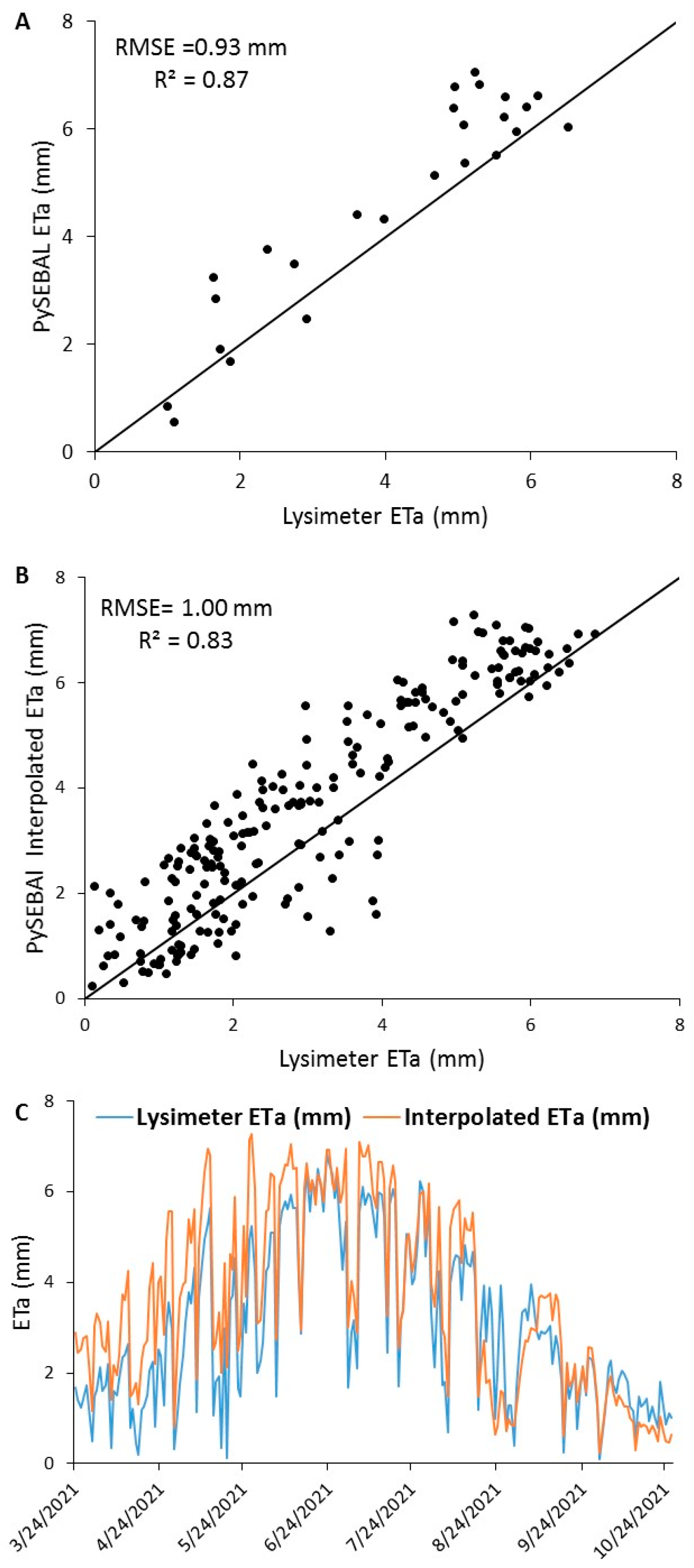
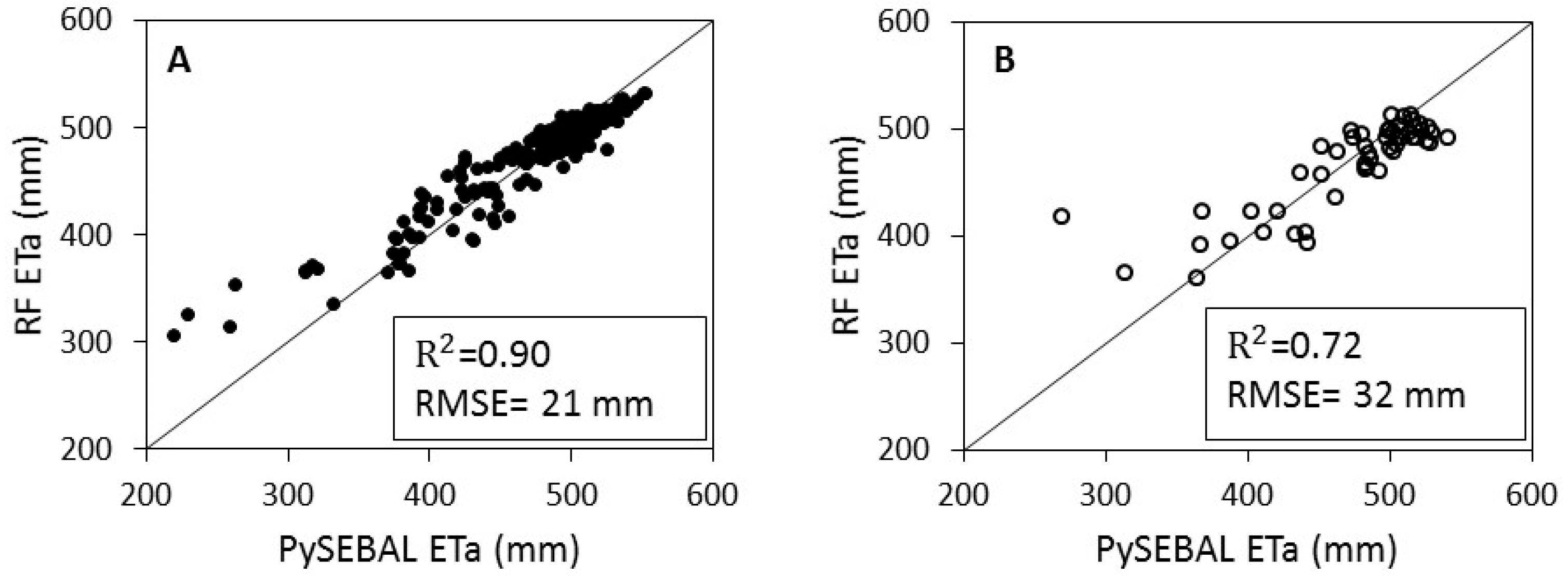

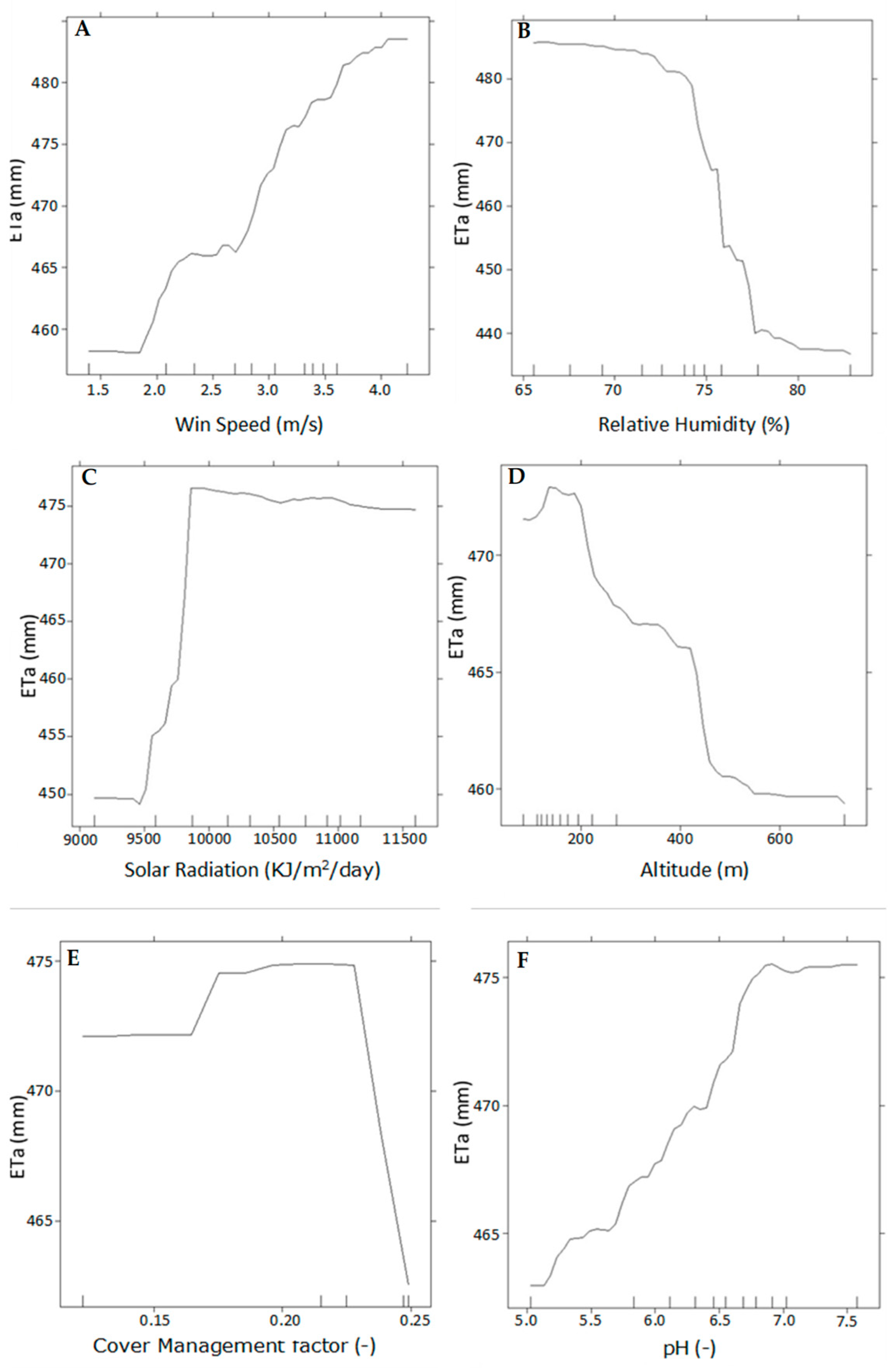
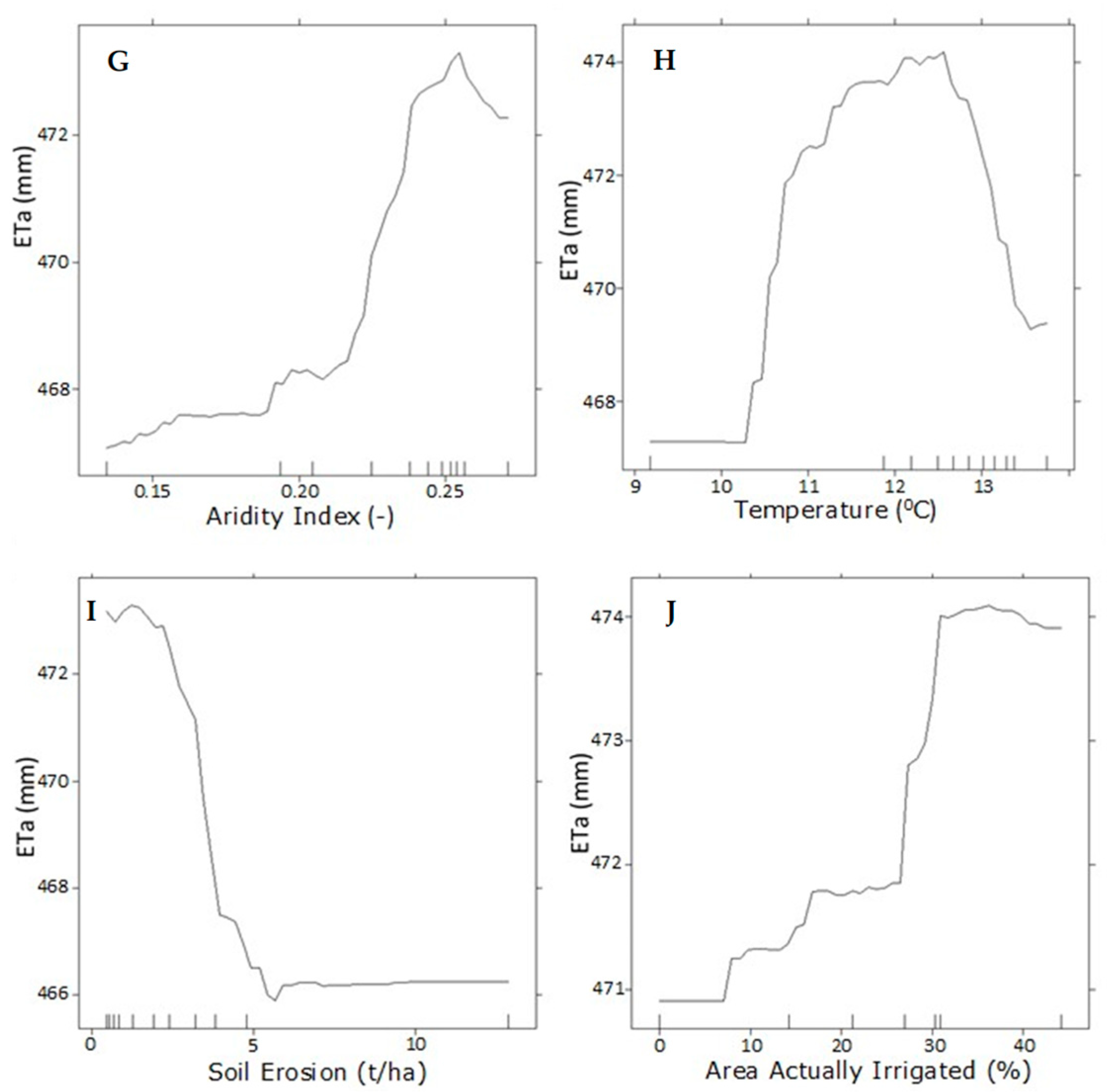

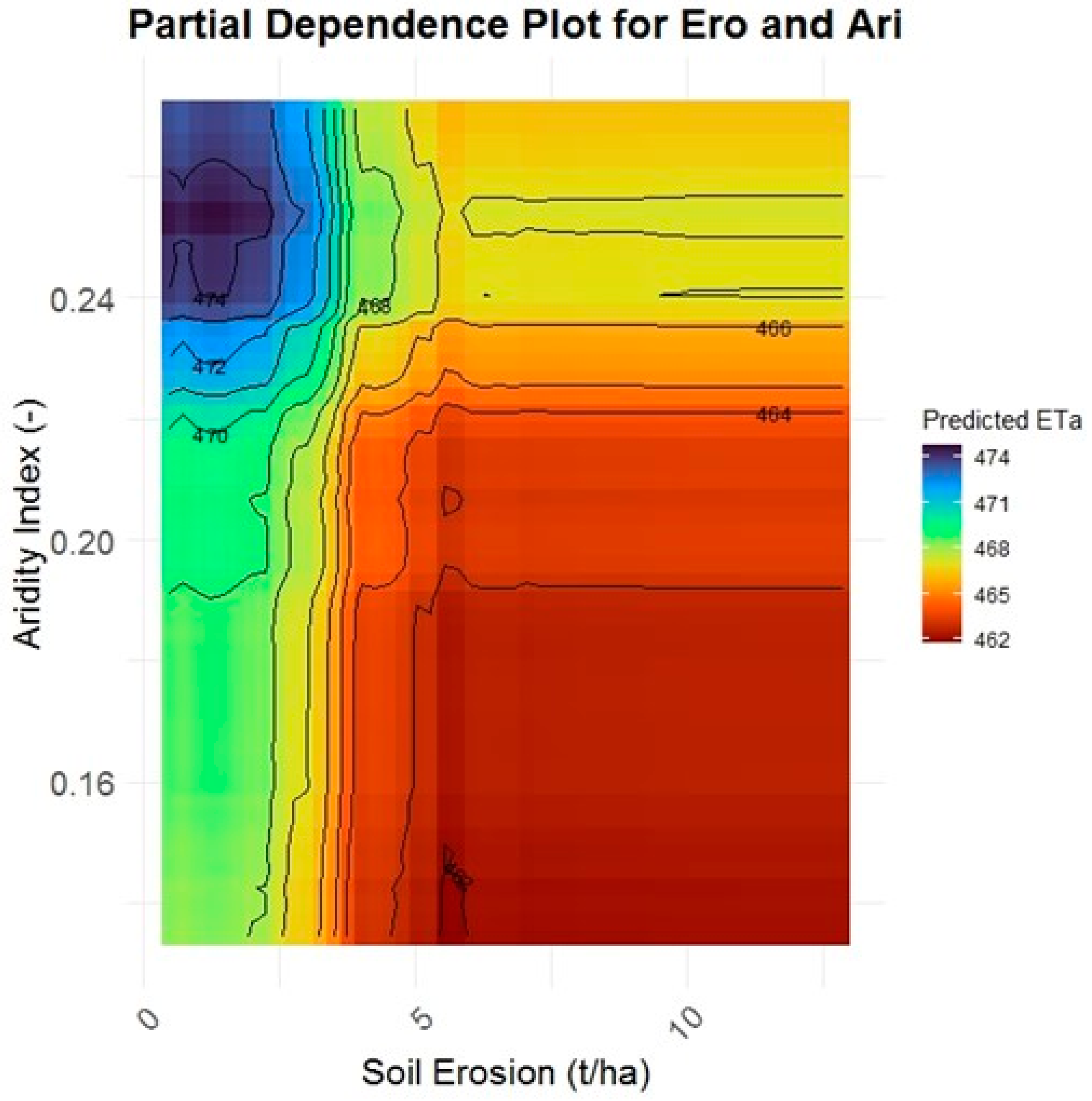
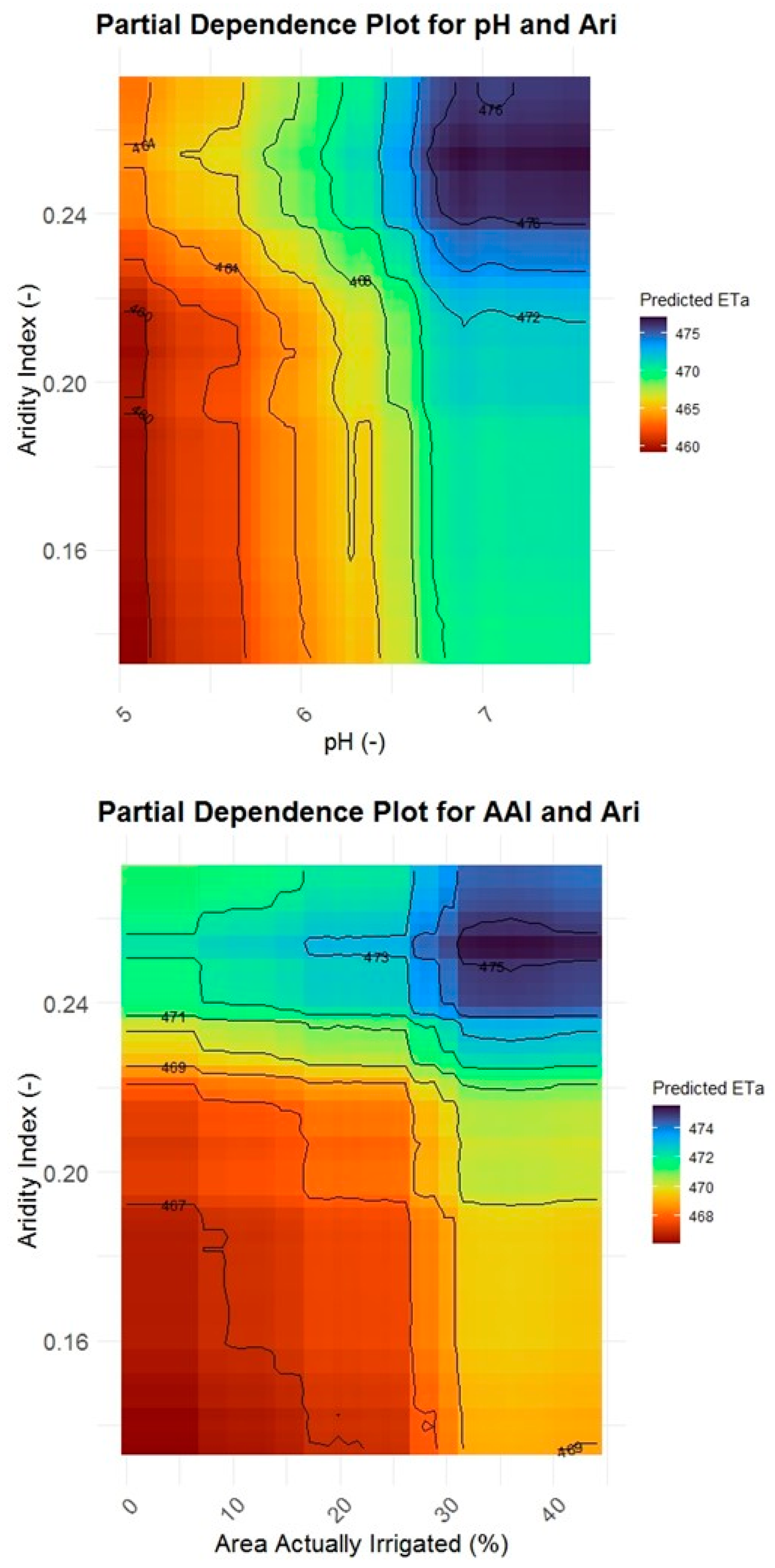

| Sowing Dates | |||||
| Df | Sum Sq | Mean Sq | F Value | Pr(>F) | |
| Plots | 47 | 5539.17 | 117.85 | 1.53 | 0.068 n.s. |
| Years | 2 | 298.07 | 149.04 | 1.93 | 0.1551n.s. |
| Residuals | 52 | 4010.93 | 77.13 | ||
| Harvesting Dates | |||||
| Df | Sum Sq | Mean Sq | F Value | Pr(>F) | |
| Plots | 51 | 14,070.14 | 275.89 | 12.03 | 1.46 × 10−23 *** |
| Years | 3 | 665.53 | 221.84 | 9.67 | 1.37 × 10−5 *** |
| Residuals | 89 | 2041.64 | 22.94 | ||
| Cropping Season | Mean (mm) | CV (%) | Min (mm) | Max (mm) |
|---|---|---|---|---|
| 2008/2009 | 466.50 | 17 | 220.00 | 552.80 |
| 2011/2012 | 506.12 | 3 | 440.40 | 543.97 |
| 2014/2015 | 481.45 | 8 | 381.59 | 540.20 |
| 2017/2018 | 434.87 | 15 | 230.58 | 534.12 |
| Category | Predictors | Unit | Mean | Min | Max | CV (%) |
|---|---|---|---|---|---|---|
| Soil | Alt | m | 187.49 | 85.00 | 730.00 | 56 |
| Bulk | g cm−3 | 1.22 | 0.87 | 1.42 | 11 | |
| CaCO3 | g kg−1 | 28.58 | 0.00 | 125.68 | 56 | |
| CEC | cmol(+) kg−1 | 20.71 | 11.83 | 28.35 | 16 | |
| Clay | % | 28.40 | 16.84 | 54.91 | 21 | |
| C/N | - | 9.94 | 8.42 | 12.24 | 6 | |
| Text_USDA | - | 5.73 | 2.00 | 9.00 | 45 | |
| K | mg kg−1 | 256.86 | 114.38 | 396.12 | 21 | |
| N | g kg−1 | 1.73 | 0.93 | 2.92 | 17 | |
| P | mg kg−1 | 33.48 | 18.50 | 49.50 | 17 | |
| pH | - | 6.48 | 5.03 | 7.57 | 7 | |
| C | g kg−1 | 16.50 | 12.34 | 48.56 | 29 | |
| Ero | t ha−1 | 2.41 | 0.48 | 12.88 | 78 | |
| k_Factor | t ha h ha−1 MJ−1 mm−1 | 0.04 | 0.03 | 0.06 | 13 | |
| Weather | Ari | - | 0.23 | 0.13 | 0.27 | 13 |
| Win | m s−1 | 2.94 | 1.31 | 4.23 | 20 | |
| Rad | KJ m−2 day−1 | 10,472.15 | 9115.37 | 11,592.52 | 6 | |
| RH | % | 73.03 | 65.59 | 82.84 | 5 | |
| Temp | °C | 12.65 | 8.65 | 13.74 | 7 | |
| Crop Management | CF | - | 0.23 | 0.10 | 0.25 | 9 |
| CF_Till | - | 0.24 | 0.22 | 0.25 | 5 | |
| CF_Res | - | 0.27 | 0.27 | 0.28 | 1 | |
| CF_Cov | - | 0.27 | 0.27 | 0.28 | 1 | |
| AAI | % area of 5 minutes resolution | 13.76 | 0.00 | 44.13 | 101 | |
| AEI | 14.64 | 0.00 | 75.09 | 159 |
Disclaimer/Publisher’s Note: The statements, opinions and data contained in all publications are solely those of the individual author(s) and contributor(s) and not of MDPI and/or the editor(s). MDPI and/or the editor(s) disclaim responsibility for any injury to people or property resulting from any ideas, methods, instructions or products referred to in the content. |
© 2025 by the authors. Licensee MDPI, Basel, Switzerland. This article is an open access article distributed under the terms and conditions of the Creative Commons Attribution (CC BY) license (https://creativecommons.org/licenses/by/4.0/).
Share and Cite
Sawadogo, A.; Kouadio, L.; Traoré, F.; Nejedlik, P. Assessing Key Factors Affecting Water Use in Winter Wheat in Slovakia Using Earth Observation Data and Random Forest-Based Model. Agronomy 2025, 15, 2462. https://doi.org/10.3390/agronomy15112462
Sawadogo A, Kouadio L, Traoré F, Nejedlik P. Assessing Key Factors Affecting Water Use in Winter Wheat in Slovakia Using Earth Observation Data and Random Forest-Based Model. Agronomy. 2025; 15(11):2462. https://doi.org/10.3390/agronomy15112462
Chicago/Turabian StyleSawadogo, Alidou, Louis Kouadio, Farid Traoré, and Pavol Nejedlik. 2025. "Assessing Key Factors Affecting Water Use in Winter Wheat in Slovakia Using Earth Observation Data and Random Forest-Based Model" Agronomy 15, no. 11: 2462. https://doi.org/10.3390/agronomy15112462
APA StyleSawadogo, A., Kouadio, L., Traoré, F., & Nejedlik, P. (2025). Assessing Key Factors Affecting Water Use in Winter Wheat in Slovakia Using Earth Observation Data and Random Forest-Based Model. Agronomy, 15(11), 2462. https://doi.org/10.3390/agronomy15112462






